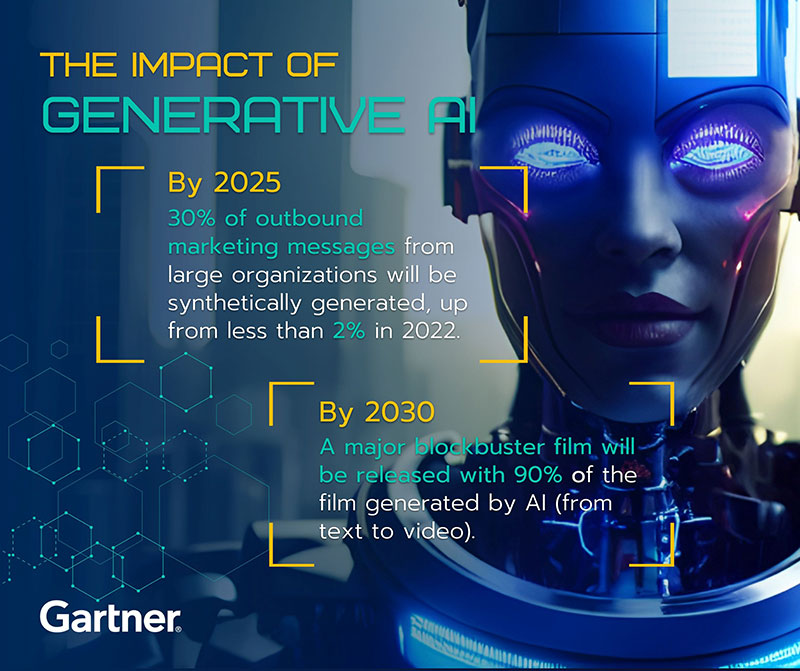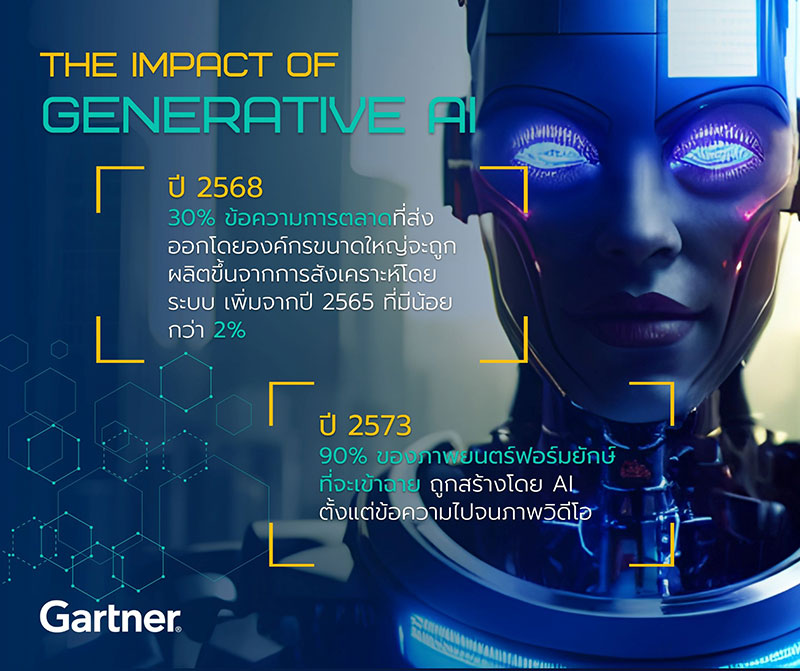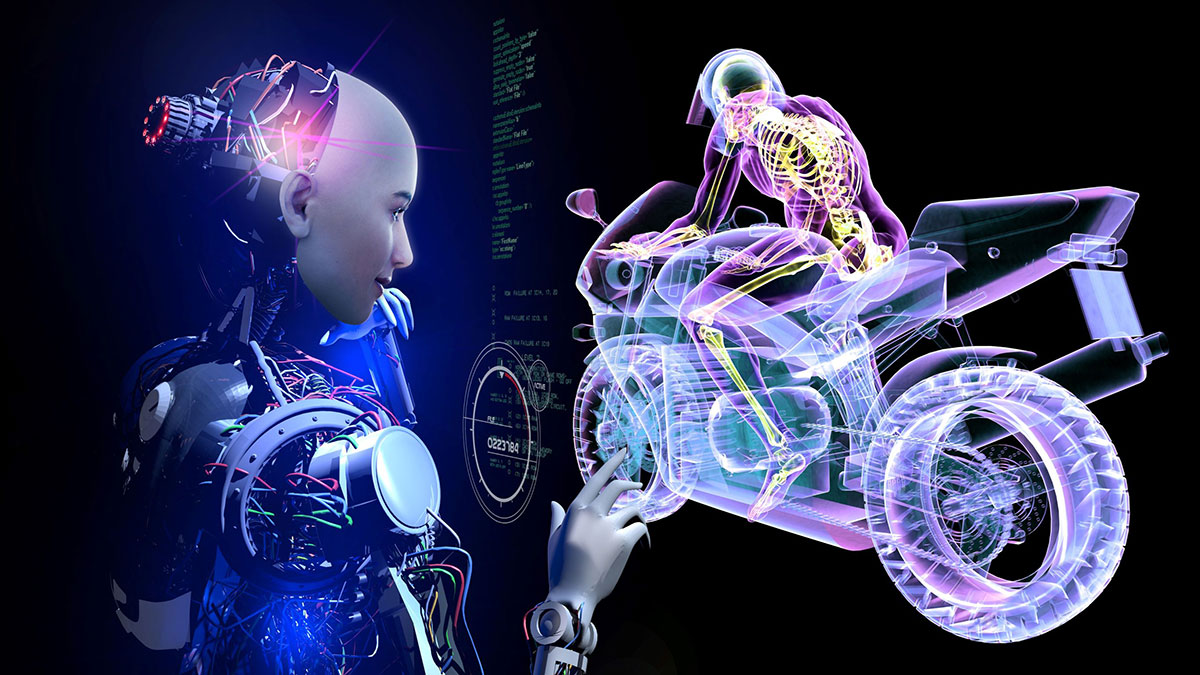By Brian Burke, Research VP for Technology Innovation at Gartner
ChatGPT, while cool, is just the beginning; enterprise uses for generative AI are far more sophisticated.
Venture capital firms have invested over US$1.7 billion in generative AI solutions over the last three years, with AI-enabled drug discovery and AI software coding receiving the most funding.

Early foundation models like ChatGPT focus on the ability of generative AI to augment creative work, but we expect more than 30% of new drugs and materials to be systematically discovered using generative AI techniques by 2025 – up from zero today. And that is just one of numerous industry use cases.
Uses cases for generative AI
Generative AI can explore many possible designs of an object to find the right or most suitable match. It not only augments and accelerates design in many fields, it also has the potential to “invent” novel designs or objects that humans may have missed otherwise.
Marketing and media are already feeling the impacts of generative AI. Gartner predicts that 30% of outbound marketing messages from large organizations will be synthetically generated by 2025, up from less than 2% in 2022. In addition, a major blockbuster film will be released by 2030 with 90% of the film generated by AI (from text to video).
Still, AI innovations are generally accelerating, creating numerous use cases for generative AI in various industries.
- Drug Design
Generative AI has already been used to design drugs for various uses within months, rather than years, offering pharma significant opportunities to reduce both the costs and timeline of drug discovery.
- Material Science
Generative AI is impacting the automotive, aerospace, defense, medical, electronics and energy industries by composing entirely new materials targeting specific physical properties.
The process, called inverse design, defines the required properties and discovers materials likely to have those properties rather than relying on serendipity to find a material that possesses them. The result is to find, for example, materials that are more conductive or greater magnetic attraction than those currently used in energy and transportation — or for use cases where materials need to be resistant to corrosion.
- Chip Design
Generative AI can use reinforcement learning (a machine learning technique) to optimize component placement in semiconductor chip design (floorplanning), reducing product-development life cycle time from weeks with human experts to hours with generative AI.
- Synthetic data
Generative AI is one way of creating synthetic data, a class of data that is generated rather than obtained from direct observations of the real world. This ensures the privacy of the original sources of the data that was used to train the model. For example, healthcare data can be artificially generated for research and analysis without revealing the identity of patients whose medical records were used to ensure privacy.
- Parts design
Generative AI enables industries, including manufacturing, automotive, aerospace and defense, to design parts that are optimized to meet specific goals and constraints, such as performance, materials and manufacturing methods. Automakers, for example, can use generative design to innovate lighter designs — contributing to their goals of making cars more fuel efficient.

Embedding the right technologies
Most AI systems today are classifiers, meaning they can be trained to distinguish between images of dogs and cats. Generative AI systems can be trained to generate an image of a dog or a cat that doesn’t exist in the real world. The ability for technology to be creative is a game changer.
Generative AI enables systems to create high-value artifacts, such as video, narrative, training data and even designs and schematics.
Generative Pre-trained Transformer (GPT), for example, is the large-scale natural language technology that uses deep learning to produce human-like text. The third generation (GPT-3), which predicts the most likely next word in a sentence based on its absorbed accumulated training, can write stories, songs and poetry, and even computer code — and enables ChatGPT to do your teenager’s homework in seconds.
Beyond text, digital-image generators, such as DALL·E 2, Stable Diffusion and Midjourney, can generate images from text.
Don’t forget the risks
Before you forge full-speed ahead, remember that generative AI doesn’t just present opportunities for business, the threats are real too. Some examples include the potential for deepfakes, copyright issues and other malicious uses of generative AI technology to target your organization.
Work with security and risk management leaders to proactively mitigate the reputational, counterfeit, fraud and political risks that malicious uses of generative AI present to individuals, organizations and governments.
Also consider implementing guidance on the responsible use of generative AI through a curated list of approved vendors and services, prioritizing those that strive to provide transparency on training datasets and appropriate model usage, and/or offer their models in open source.
อนาคตการใช้ Generative AI ในภาคองค์กร
โดย ไบรอัน เบิร์ก รองประธานฝ่ายวิจัยด้านนวัตกรรมและเทคโนโลยี การ์ทเนอร์ อิงค์
แม้ ChatGPT จะมีความสามารถที่น่าสนใจแต่ก็เรียกได้ว่ายังอยู่ในขั้นเริ่มต้น ซึ่งการใช้งาน Generative AI ในภาคองค์กรนั้นไปไกลและซับซ้อนกว่ามาก
ช่วงสามปีที่ผ่านมา มีบริษัท Venture Capital (VC) หลายแห่งลงทุนในโซลูชัน Generative AI ต่าง ๆ เป็นมูลค่ามากกว่า 1.7 พันล้านดอลลาร์สหรัฐฯ โดยเฉพาะการลงทุนกับการค้นพบยาด้วย AI และการเข้ารหัสซอฟต์แวร์ AI เป็นสองกลุ่มที่ได้รับเงินทุนมากที่สุด

โมเดลพื้นฐานในยุคแรก ๆ เช่น ChatGPT โฟกัสไปยังความสามารถของ Generative AI เพื่อเสริมงานด้านครีเอทีฟ แต่เราคาดว่าภายในปี ค.ศ. 2025 ยาและวัสดุการผลิตใหม่ ๆ มากกว่า 30% จะเป็นการค้นพบอย่างเป็นระบบโดยการใช้เทคนิค Generative AI จากที่วันนี้ไม่มีเลย นั่นเป็นเพียงหนึ่งในตัวอย่างของ Use Case มากมายของการนำ Generative AI มาใช้ในอุตสาหกรรม
Use Case ต่าง ๆ ของการใช้ Generative AI
Generative AI สามารถใช้สำรวจความเป็นไปได้ของการออกแบบวัตถุได้หลากหลายเพื่อค้นหาสิ่งที่เหมาะสมที่สุด ไม่เพียงแต่เสริมและเร่งการออกแบบในหลาย ๆ ด้านเท่านั้น แต่ยังมีศักยภาพในการ “ประดิษฐ์คิดค้น (Invent)” นวัตกรรมการออกแบบ หรือ วัสดุที่มนุษย์อาจมองพลาดไปเป็นอย่างอื่น
ในแวดวงการตลาดและสื่อต่างรับรู้ถึงผลกระทบของ Generative AI ซึ่งการ์ทเนอร์คาดว่า ภายในปี 2568 ประมาณ 30% ของข้อความด้านการตลาดที่ส่งออกโดยองค์กรใหญ่ ๆ จะถูกสร้างขึ้นจากการสังเคราะห์โดยระบบ โดยเพิ่มขึ้นจากปี 2565 ที่มีน้อยกว่า 2% นอกจากนี้ ภายในปี 2573 ประมาณ 90% ของภาพยนตร์ฟอร์มยักษ์ที่จะเข้าฉายจะสร้างด้วย AI (ตั้งแต่ตัวหนังสือไปจนภาพเคลื่อนไหว)
อย่างไรก็ตามโดยทั่วไปแล้วนวัตกรรมเอไอมักจะเกิดขึ้นอย่างรวดเร็ว ซึ่ง Generative AI ได้สร้าง Use Cases มากมายในอุตสาหกรรมต่าง ๆ
- การออกแบบและพัฒนายารักษาโรค (Drug Design)
Generative AI ถูกนำมาใช้ออกแบบและพัฒนายารักษาโรคสำหรับใช้ในกรณีต่าง ๆ แทนที่ต้องใช้เวลาหลายปี กลับย่นระยะเวลาให้เหลือเพียงไม่กี่เดือน เป็นโอกาสสำคัญของภาคเภสัชกรรมที่สามารถช่วยลดค่าใช้จ่ายและระยะเวลาในการค้นพบยาตัวใหม่ได้อย่างมีนัยสำคัญ
- วัสดุศาสตร์(Material Science)
เทคโนโลยี Generative AI กำลังส่งผลกระทบต่ออุตสาหกรรมยานยนต์ การบินและอวกาศ การป้องกันประเทศ การแพทย์ รวมถึงอุตสาหกรรมอิเล็กทรอนิกส์และพลังงาน โดยสามารถประกอบวัสดุขึ้นใหม่ทั้งหมดพร้อมกำหนดคุณสมบัติทางกายภาพได้อย่างเฉพาะ
กระบวนการนี้เรียกว่า Inverse Design สามารถกำหนดคุณสมบัติที่ต้องการและค้นหาวัสดุที่มีคุณสมบัติตรงตามที่กำหนดไว้ แทนที่จะอาศัยความบังเอิญเพื่อค้นหาวัสดุที่มีคุณสมบัติดังกล่าว ผลลัพธ์ที่ได้คือการค้นหา ตัวอย่างเช่น การค้นหาวัสดุที่เป็นตัวเหนี่ยวนำไฟฟ้าหรือมีแรงดึงดูดของแม่เหล็กมากกว่าวัสดุที่ใช้ในด้านพลังงานและการขนส่งในปัจจุบัน หรือการค้นหาวัสดุที่จำเป็นต้องมีความทนทานต่อการกัดกร่อน เป็นต้น
- การออกแบบชิป (Chip Design)
Generative AI สามารถใช้การเรียนรู้แบบเสริมกำลัง (Reinforcement Learning) ซึ่งเป็นเทคนิคหนึ่งทางด้าน Machine Learning สำหรับเพิ่มประสิทธิภาพการจัดวางองค์ประกอบในการออกแบบแผงวงจรของเซมิคอนดักเตอร์ (Floorplanning) ซึ่ง Generative AI ช่วยย่นระยะเวลาของวงจรการพัฒนาผลิตภัณฑ์จากเดิมหลายสัปดาห์ที่ต้องทำงานร่วมกับผู้เชี่ยวชาญมนุษย์เหลือเป็นรายชั่วโมงแทน
- ข้อมูลสังเคราะห์ (Synthetic Data)
Generative AI เป็นหนทางเดียวในการสร้างข้อมูลสังเคราะห์ (Synthetic Data) ซึ่งเป็นประเภทข้อมูลที่ถูกสร้างขึ้นโดยอัลกอริทึมที่สำคัญกว่าข้อมูลที่รวบรวมโดยตรงมาจากบุคคลจริง ทำให้มั่นใจถึงความเป็นส่วนตัวของแหล่งข้อมูลดั้งเดิมที่ใช้ในการฝึกโมเดล ตัวอย่างเช่น ฐานข้อมูลด้านสุขภาพที่สามารถสร้างขึ้นเพื่อการวิจัยและวิเคราะห์โดยไม่ต้องเปิดเผยตัวตนของผู้ป่วย ซึ่งใช้เวชระเบียนรับรองความเป็นส่วนตัว
- การออกแบบชิ้นส่วนประกอบต่าง ๆ (Parts Design)
Generative AI ช่วยให้อุตสาหกรรมต่าง ๆ ประกอบด้วย ภาคการผลิต ยานยนต์ การบินและอวกาศ และการป้องกันประเทศ สามารถออกแบบชิ้นส่วนประกอบต่าง ๆ ได้อย่างมีประสิทธิภาพ เพื่อบรรลุเป้าหมายและข้อจำกัดได้ตามที่กำหนด อาทิ ในด้านประสิทธิภาพ ชนิดวัสดุและวิธีการผลิต ตัวอย่าง ผู้ผลิตรถยนต์สามารถใช้ Generative Design เพื่อคิดค้นการออกแบบที่เน้นน้ำหนักเบาขึ้น นำไปสู่เป้าหมายในการทำให้รถยนต์ประหยัดน้ำมันมากขึ้น เป็นต้น
การฝังเทคโนโลยีต่าง ๆ อย่างเหมาะสม
ปัจจุบันระบบ AI ส่วนใหญ่จะถูกแยกเป็นประเภทต่าง ๆ หมายความว่า มันสามารถรับการฝึกและแยกแยะความแตกต่างระหว่างภาพสุนัขและแมวได้ ซึ่ง Generative AI สามารถฝึกฝนให้สร้างภาพสุนัขหรือแมวที่ไม่มีอยู่ในโลกจริงได้ ซึ่งความสามารถในการสร้างสรรค์เทคโนโลยีนี้คือ Game Changer
Generative AI ทำให้ระบบต่าง ๆ สามารถสร้างสิ่งประดิษฐ์ที่มีมูลค่าสูงได้ อาทิ วิดีโอ การเล่าเรื่อง ข้อมูลการฝึกอบรม หรือแม้แต่การออกแบบและสร้างแผนผังวงจรไฟฟ้าหรืออิเล็กทรอนิกส์ต่าง ๆ
ตัวอย่างเช่น Generative Pre-trained Transformer (GPT) ซึ่งเป็นเทคโนโลยีภาษาธรรมชาติขนาดใหญ่ ที่ใช้ในการเรียนรู้เชิงลึกเพื่อสร้างข้อความได้เหมือนมนุษย์ โดยในเจเนอเรชั่นที่ 3 (GPT-3) สามารถคาดการณ์คำที่จะใช้ในประโยคถัดไปตามการฝึกฝนที่สั่งสมมาในระบบ นอกจากนี้ยังสามารถเขียนเรื่องราว แต่งเพลงและประพันธ์บทกวี หรือแม้แต่เขียนโค้ดโปรแกรมในคอมพิวเตอร์ และ ChatGPT ยังช่วยนักเรียนทำการบ้านได้ในไม่กี่วินาที
นอกเหนือจากข้อความ (Text) แล้วยังสามารถสร้างภาพดิจิทัล อย่าง DALL·E 2, Stable Diffusion และ Midjourney ที่เป็น AI ที่สามารถสร้างภาพต่าง ๆ ได้จากข้อความ
ห้ามลืมเรื่องความเสี่ยง
ก่อนที่องค์กรจะเดินหน้าอย่างเต็มรูปแบบกับ Generative AI ต้องระลึกเสมอว่า นอกจากโอกาสทางธุรกิจแล้ว Generative AI ยังมีภัยคุกคามอยู่เช่นกัน เช่น ความเป็นไปได้ในการปลอมแปลงข้อมูลแบบ Deepfakes ปัญหาเรื่องลิขสิทธิ์ และการใช้เทคโนโลยี Generative AI ในทางที่ผิดเพื่อมุ่งเป้าโจมตีองค์กร
องค์กรต้องทำงานร่วมกับผู้บริหารด้านความปลอดภัยและจัดการความเสี่ยง เพื่อลดความเสี่ยงแบบเชิงรุกจากการเสื่อมเสียชื่อเสียง การปลอมแปลง การล่อลวง และในเรื่องของการเมือง ที่เกิดจากการใช้ Generative AI ในทางที่ผิดทั้งต่อปัจเจกบุคคล องค์กรธุรกิจและภาครัฐบาล
องค์กรควรพิจารณาคำแนะนำการใช้ Generative AI อย่างมีความรับผิดชอบ ผ่านรายชื่อผู้จัดจำหน่ายและผู้ให้บริการที่ได้รับการรับรอง พร้อมให้ความสำคัญกับองค์กรที่มีความมุ่งมั่นสร้างความโปร่งใสในชุดข้อมูลการฝึกอบรมและการใช้โมเดลอย่างเหมาะสม และ/หรือนำเสนอโมเดลของพวกเขาในโอเพ่นซอร์ส



